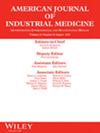Acute Kidney Injury Among Florida Construction Workers: A Pilot Study
Abstract
Background
While construction workers have the second highest rate of heat-related mortality, less is known about the prevelance of heat-related illness (HRI) symptoms, dehydration and kidney dysfunction. The aim of this study was to conduct a biomedical field-based study with construction workers to characterize HRI symptoms, dehydration, and kidney dysfunction, and analyze relationships between post-work urine specific gravity (USG) percentiles and predictors such as work hours, water consumption, and sugary beverage consumption.
Methods
In collaboration with the Farmworker Association of Florida, 58 construction workers in Central Florida were monitored pre- and post-work shift on one workday. Research staff used a recreational vehicle to meet workers at their worksites, collect blood and urine pre- and post-work shift, and administer a survey on HRI symptoms. Acute kidney injury (AKI) was measured using serum creatinine and dehydration with USG. Predictors were examined in single covariate linear quantile mixed models against USG percentiles.
Results
The mean heat index was 88.4°F. Forty-two percent reported at least one symptom of HRI. Dehydration rates were 75% pre-work shift and 78% post-work shift. Severe dehydration increased from 16% to 33%. AKI was observed in 38% of the participants.
Conclusion
This is, to our knowledge, the first US field-based biomedical study to document AKI, dehydration, and HRI symptoms in construction workers. This study adds to the literature that supports occupational heat exposure as a risk factor for AKI and dehydration.

 求助内容:
求助内容: 应助结果提醒方式:
应助结果提醒方式:


